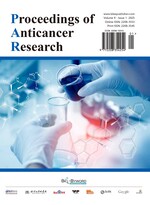Abstract
Lung cancer is among the most prevalent cancers and has the highest mortality rate globally. The diagnosis, pathohistological classification, and molecular testing of lung cancer primarily rely on tissue biopsy or surgical resection. These methods are invasive and associated with limitations, including sample quantity and quality, as well as patient tolerance. Radiomics, an emerging technology, enables the extraction of high-throughput quantitative information from medical images, providing radiomic features applicable to clinical diagnosis and treatment. Significant advancements have been made in the application of radiomics to the diagnosis, molecular detection, efficacy prediction, and prognosis of lung cancer. This review examines the progress in radiomics for individualized and precise diagnosis and treatment of lung cancer in recent years.
References
Xu Y, Hosny A, Zeleznik R, et al., 2019, Deep Learning Predicts Lung Cancer Treatment Response from Serial Medical Imaging. Clin Cancer Res, 25(11): 3266–3275. https://doi.org/10.1158/1078-0432.CCR-18-2495
Sung H, Ferlay J, Siegel RL, et al., 2021, Global Cancer Statistics 2020: GLOBOCAN Estimates of Incidence and Mortality Worldwide for 36 Cancers in 185 Countries. CA Cancer J Clin, 71(3): 209–249. https://doi.org/10.3322/caac.21660
Cancer Research UK, 2019, Types of Lung Cancer, viewed August 23, 2024. https://www.cancerresearchuk.org/about-cancer/lung-cancer/stages-typesgrades/types
Rudin CM, Brambilla E, Faivre-Finn C, et al., 2021, Small-Cell Lung Cancer. Nat Rev Dis Primers, 7(1): 3. https://doi.org/10.1038/s41572-020-00235-0
Yin X, Liao H, Yun H, et al., 2022, Artificial Intelligence-Based Prediction of Clinical Outcome in Immunotherapy and Targeted Therapy of Lung Cancer. Semin Cancer Biol, 86(Pt 2): 146–159. https://doi.org/10.1016/j.semcancer.2022.08.002
AACR Cancer Progress Report, 2024, Cancer Progress Report, viewed August 23, 2024, https://cancerprogressreport.aacr.org/progress/
Lantuejoul S, Sound-Tsao M, Cooper WA, et al., 2020, PD-L1 Testing for Lung Cancer in 2019: Perspective From the IASLC Pathology Committee. J Thorac Oncol, 15(4): 499–519. https://doi.org/10.1016/j.jtho.2019.12.107
Hu M, Wu L, Zhang X, et al., 2023, Comparative Evaluation of 2 Different Percutaneous Techniques of Simultaneous Needle Biopsy With Microwave Ablation of Suspected Malignant Pulmonary Nodules. Technol Cancer Res Treat, 22: 15330338231168458. https://doi.org/10.1177/15330338231168458
Kumar V, Gu Y, Basu S, et al., 2012, Radiomics: The Process and the Challenges. Magn Reson Imaging, 30(9): 1234–1248. https://doi.org/10.1016/j.mri.2012.06.010
Hatt M, Tixier F, Visvikis D, et al., 2017, Radiomics in PET/CT: More Than Meets the Eye? J Nucl Med, 58(3): 365–366. https://doi.org/10.2967/jnumed.116.184655
Lambin P, Rios-Velazquez E, Leijenaar R, et al., 2012, Radiomics: Extracting More Information from Medical Images Using Advanced Feature Analysis. Eur J Cancer, 48(4): 441–446. https://doi.org/10.1016/j.ejca.2011.11.036
Park YY, Park ES, Kim SB, et al., 2012, Development and Validation of a Prognostic Gene-Expression Signature for Lung Adenocarcinoma. PLoS One, 7(9): e44225. https://doi.org/10.1371/journal.pone.0044225
Hendrix N, Veenstra DL, Cheng M, et al., 2022, Assessing the Economic Value of Clinical Artificial Intelligence: Challenges and Opportunities. Value Health, 25(3): 331–339. https://doi.org/10.1016/j.jval.2021.08.015
Dennie C, Bayanati H, Souza CA, et al., 2021, Role of the Thoracic Radiologist in the Evaluation and Management of Solid and Subsolid Lung Nodules. Thorac Surg Clin, 31(3): 283–292. https://doi.org/10.1016/j.thorsurg.2021.04.004
Fan L, Fang M, Li Z, et al., 2019, Radiomics Signature: A Biomarker for the Preoperative Discrimination of Lung Invasive Adenocarcinoma Manifesting as a Ground-Glass Nodule. Eur Radiol, 29(2): 889–897. https://doi.org/10.1007/s00330-018-5530-z
Wang Y, Wu Y, Wang L, et al., 2023, Value of CT Radiomics Models Constructed by Three Algorithms to the Prediction of Mediastinal Lymph Node Metastasis in Non-Small-Cell Lung Cancer Patients. Journal of Chinese Practical Diagnosis and Therapy, 37(11): 1081–1086.
Zhu X, Dong D, Chen Z, et al., 2018, Radiomic Signature as a Diagnostic Factor for Histologic Subtype Classification of Non-Small Cell Lung Cancer. Eur Radiol, 28(7): 2772–2778. https://doi.org/10.1007/s00330-017-5221-1
Lambin P, Leijenaar RTH, Deist TM, et al., 2017, Radiomics: The Bridge Between Medical Imaging and Personalized Medicine. Nat Rev Clin Oncol, 14(12): 749–762. https://doi.org/10.1038/nrclinonc.2017.141
Lu CF, Liao CY, Chao HS, et al., 2023, A Radiomics-Based Deep Learning Approach to Predict Progression Free-Survival After Tyrosine Kinase Inhibitor Therapy in Non-Small Cell Lung Cancer. Cancer Imaging, 23(1): 9. https://doi.org/10.1186/s40644-023-00522-5
Cheng B, Deng H, Zhao Y, et al., 2022, Predicting EGFR Mutation Status in Lung Adenocarcinoma Presenting as Ground-Glass Opacity: Utilizing Radiomics Model in Clinical Translation. Eur Radiol, 32(9): 5869–5879. https://doi.org/10.1007/s00330-022-08673-y
Clay R, Kipp BR, Jenkins S, et al., 2017, Computer-Aided Nodule Assessment and Risk Yield (CANARY) May Facilitate Non-Invasive Prediction of EGFR Mutation Status in Lung Adenocarcinomas. Sci Rep, 7(1): 17620. https://doi.org/10.1038/s41598-017-17659-6
Chang R, Qi S, Wu Y, et al., 2022, Deep Multiple Instance Learning for Predicting Chemotherapy Response in Non-Small Cell Lung Cancer Using Pretreatment CT Images. Sci Rep, 12: 19829. https://doi.org/10.1038/s41598-022-24278-3
Yang F, Zhang J, Zhou L, et al., 2022, CT-Based Radiomics Signatures can Predict the Tumor Response of Non-Small Cell Lung Cancer Patients Treated with First-Line Chemotherapy and Targeted Therapy. Eur Radiol, 32(3): 1538–1547. https://doi.org/10.1007/s00330-021-08277-y
Zhang C, Ding Z, Chen P, 2023, The Value of CT Radiomics Combined with Cytokeratin-19 Fragment in Predicting the Effectiveness of EGFR-TKIs for Non-Small Cell Lung Cancer with EGFR Mutation. Radiologic Practice, 38(12): 1532–1538.
Tian Q, Feng F, Chen Q, et al., 2023, CT Radiomics Nomogram for Evaluating Programmed Death Receptor 1 Expression of Non-Small Cell Lung Cancer. Chinese Journal of Medical Imaging Technology, 39(4): 543–548.
Wang H, Wang H, Wang X, et al., 2023, The Value of Nomogram Model Based on CT Radiomics in Predicting the Efficacy of Stereotactic Body Radiotherapy for Lung Tumors. Journal of Modern Oncology, 31(5): 898–904.
Sawayanagi S, Yamashita H, Nozawa Y, et al., 2022, Establishment of a Prediction Model for Overall Survival after Stereotactic Body Radiation Therapy for Primary Non-Small Cell Lung Cancer Using Radiomics Analysis. Cancers (Basel), 14(16): 3859. https://doi.org/10.3390/cancers14163859
Niu L, Chu X, Yang X, et al., 2023, A Multiomics Approach-Based Prediction of Radiation Pneumonia in Lung Cancer Patients: Impact on Survival Outcome. J Cancer Res Clin Oncol, 149(11): 8923–8934. https://doi.org/10.1007/s00432-023-04827-7
Huang B, Sollee J, Luo YH, et al., 2022, Prediction of Lung Malignancy Progression and Survival with Machine Learning Based on Pre-Treatment FDG-PET/CT. EBioMedicine, 82: 104127. https://doi.org/10.1016/j.ebiom.2022.104127
Zheng X, Liu K, Li C, et al., 2023, A CT-Based Radiomics Nomogram for Predicting the Progression-Free Survival in Small Cell Lung Cancer: A Multicenter Cohort Study. Radiol Med, 128(11): 1386–1397. https://doi.org/10.1007/s11547-023-01702-w
